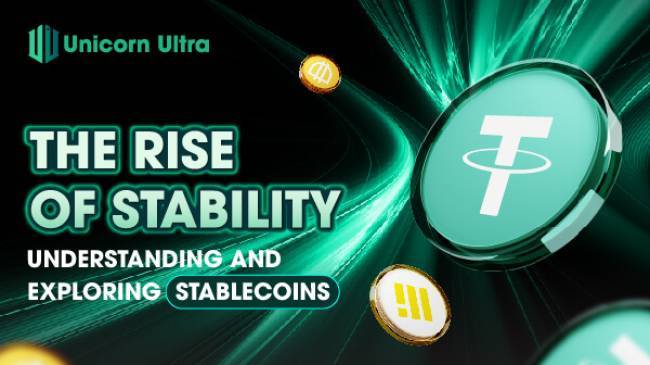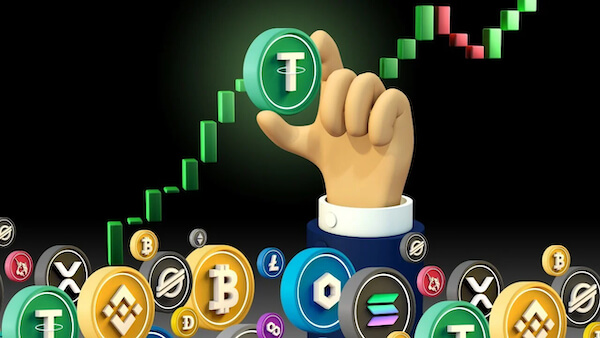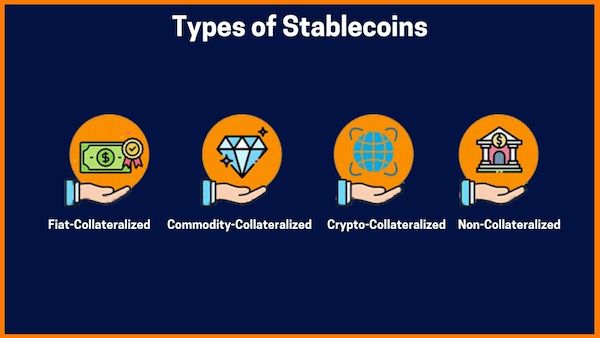Stablecoins have emerged as a fascinating and integral part of the cryptocurrency landscape. In a realm known for its wild price swings and speculative fervor, stablecoins provide a much-needed anchor. If you've ever wondered, "What are stablecoins?" you're in the right place. In this article, we'll delve deep into the world of stablecoins, exploring their definition, mechanics, and the reasons behind their rapid rise. So, fasten your seatbelts as we embark on this informative journey through the stablecoin universe.
Table of Contents
What are stablecoins?
What are stablecoins in crypto? Stablecoins are cryptocurrencies designed to maintain a steady value by anchoring themselves to external references, offering an alternative to the high price fluctuations seen in popular cryptocurrencies like Bitcoin (BTC), which have rendered them less practical for everyday transactions.
Stablecoins strive to tether their market worth to external benchmarks, making them more reliable for use as a medium of exchange compared to their more volatile cryptocurrency counterparts.
These stablecoins can be linked to established currencies like the U.S. dollar or the value of commodities such as gold.
To achieve price stability, stablecoins employ either reserve assets as collateral or algorithmic formulas intended to manage their supply.
Regulators are closely monitoring stablecoins due to the rapid expansion of the $128 billion market and its potential impact on the broader financial system.

How do stablecoins work?
Like any emerging asset class, cryptocurrencies are vulnerable to market forces. Consequently, numerous cryptocurrency projects are actively investigating methods to mitigate risk and enhance participation in the broader cryptocurrency ecosystem. The existing solutions surpass the traditional market's buy, sell, and stop orders. Instead, they are integrating price stability directly into the assets themselves. This has given rise to an entirely new segment of the cryptocurrency market known as stablecoins. These tokens are designed to operate exactly as their name implies—by maintaining stability.
During the period of 2020–21, the stablecoin market witnessed a significant surge, with its market capitalization nearly tripling. However, what is the precise driving force behind this growing appeal? To answer this question, let's begin by revisiting the fundamental categorization of stablecoins.
Why are stablecoins so important?
While Bitcoin maintains its position as the most popular cryptocurrency, it is characterized by significant price volatility and exchange rate fluctuations. For example, in March 2020, Bitcoin's price was just below $5,000, but by April 2021, it had surged to over $63,000, only to subsequently plummet by nearly 50% over the next two months. Additionally, intraday price swings can be extremely erratic, with the cryptocurrency frequently experiencing fluctuations exceeding 10% within a matter of hours.
While this volatility may be advantageous for traders, it transforms routine transactions, such as purchases, into risky ventures for both buyers and sellers. Investors who hold cryptocurrencies with the expectation of long-term value appreciation are wary of repeating scenarios like the infamous case of paying 10,000 Bitcoins for two pizzas. Simultaneously, most merchants are reluctant to accept cryptocurrencies as payment, fearing potential losses if the cryptocurrency's value drops significantly after the transaction.
To function effectively as a medium of exchange, a non-legal tender currency must maintain a relatively stable value, providing confidence to those who accept it that it will retain its purchasing power in the short term. In the realm of traditional fiat currencies, daily fluctuations of even 1% in forex trading are infrequent.
Stablecoins, as their name suggests, aim to tackle this issue by committing to maintain the cryptocurrency's value stability through various means.

What are the most popular stablecoins in crypto?
To provide you with an insight into the stablecoin landscape's ongoing innovation, let's explore some of the leading stablecoins in crypto:
Tether (USDT)
Tether, established in 2014, stands as one of the oldest stablecoins and continues to be the most widely adopted. It boasts significant market capitalization and holds a prominent position in the cryptocurrency space. USDT primarily serves as a means for swift money transfer between exchanges, enabling traders to capitalize on arbitrage opportunities arising from variations in cryptocurrency prices across different platforms. Beyond this primary use, USDT has discovered additional applications. Notably, Chinese importers based in Russia have employed USDT to transfer substantial sums across borders, bypassing China's stringent capital controls.
Tether Ltd., the entity responsible for issuing USDT, was embroiled in a 22-month legal dispute with the New York Attorney General over allegations of attempting to conceal an $850 million deficit by tapping into Tether's funds. Ultimately, on February 23, 2021, the case reached resolution, with Tether and Bitfinex (a sister company of Tether) agreeing to pay $18.5 million and to provide quarterly reports disclosing Tether's stablecoin reserves for the subsequent two years.
USD Coin (USDC)
USD Coin emerged in 2018 as a stablecoin introduced collaboratively by cryptocurrency firms Circle and Coinbase through the Centre Consortium. Similar to Tether's initial model, USDC maintains a peg to the U.S. dollar. USDC distinguishes itself as an open-source protocol, enabling any individual or entity to leverage it for the development of their products.
On July 8, 2021, Circle disclosed its intention to go public via a $4.5 billion SPAC merger with Concord Acquisition Corp. This announcement followed a $440 million funding round, featuring prominent industry players such as FTX, Digital Currency Group (CoinDesk's parent company), and Fidelity Management and Research Company, further cementing USDC's position in the cryptocurrency landscape.
Dai
Dai operates within the MakerDAO protocol and exists as a stablecoin operating on the Ethereum blockchain. Launched in 2015, Dai maintains its value by being pegged to the U.S. dollar and is backed by ether, Ethereum's native token.
Dai differentiates itself from other stablecoins through its pursuit of decentralization. Rather than relying on a central authority, Dai's operation hinges on Ethereum smart contracts, which encode immutable rules governing the system. Nonetheless, this innovative approach is not without its challenges, as evidenced by a situation in 2020 where the smart contracts supporting MakerDAO were exploited, leading to losses amounting to $8 million.

What can you do with stablecoins in crypto?
- Mitigate Volatility: Stablecoins provide a means to reduce the impact of price fluctuations associated with cryptocurrencies such as Bitcoin and Ether. By pegging their value to more stable currencies, they offer assurance to buyers and sellers that the worth of their tokens won't experience unpredictable surges or crashes in the near term.
- Facilitate Trading and Saving: Holding stablecoins doesn't require a traditional bank account, and they facilitate easy transfers. Their value can be swiftly transmitted globally, even to regions where obtaining U.S. dollars may be challenging or where the local currency exhibits instability.
- Earn Enhanced Rewards: Stablecoin investments often yield rewards that surpass what traditional banks typically offer, providing an attractive option for those seeking better returns on their investments.
- Cost-Effective Money Transfer: Some individuals have successfully transferred substantial sums, equivalent to a million dollars in USDC, with transfer fees amounting to less than a dollar.
- Streamlined International Transactions: The quick processing and minimal transaction fees associated with stablecoins like USDC make them a practical choice for sending money to any location around the world.
Do stablecoins have any drawbacks?
There are a few drawbacks associated with stablecoins that should be taken into consideration. Due to their typical setup, stablecoins have distinct challenges compared to other cryptocurrencies.
One notable concern pertains to counterparty risk when reserves are held by a bank or another third party. This essentially raises the question of whether the entity genuinely possesses the collateral it claims to hold. This question has frequently arisen in the case of Tether, for example, regarding the maintenance of a genuine 1-1 backing between USDT tokens and U.S. dollars.
In a worst-case scenario, it is possible for the reserves supporting a stablecoin to prove inadequate to redeem all units, potentially undermining confidence in the coin.
Cryptocurrencies were originally designed to eliminate the need for intermediary companies that users typically trust with their funds. Intermediaries inherently wield control over these funds, often possessing the ability to halt transactions. Some stablecoins reintroduce the possibility of transaction interference.
USD Coin, for instance, openly includes a mechanism to halt payments if coins are used for illicit purposes. Circle, one of the entities behind USDC, confirmed in July 2020 that it froze $100,000 worth of the stablecoin at the request of law enforcement.
Conclusion
In conclusion, stablecoins have carved out a significant niche within the ever-evolving cryptocurrency ecosystem. They provide stability in an otherwise turbulent market, making them a preferred choice for both investors and everyday users. As the world of finance continues to evolve, the importance of stablecoins in facilitating seamless transactions and preserving value cannot be overstated. So, the next time someone asks you, "What are stablecoins in crypto?" you can confidently explain that they are a pivotal innovation that has brought stability to the volatile world of cryptocurrencies. Follow Uniultra.xyz to update more interesting information and knowledge about blockchain






